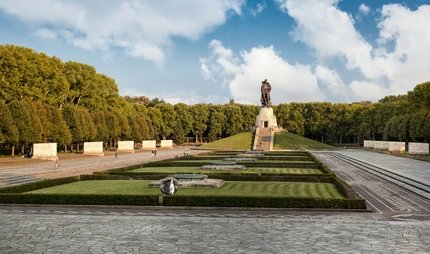
A fishing village, an industrial area and the captain’s legend
History and stories from Treptow-Köpenick
Treptow-Köpenick has plenty to tell: at least 800 years of history. Köpenick was first mentioned in records in 1210. In 1688 work started on the construction of Schloss Köpenick, which still stands proudly today on the island in front of the historic centre. The story of the Captain of Köpenick made the town famous in 1906. Köpenick has been part of Berlin since 1920.
Many museums and exhibitions tell the story of the borough. At the entrance to Köpenick city hall is the statue of the cobbler Wilhelm Voigt, the fake Captain of Köpenick who hoodwinked a troop of soldiers into taking his command, occupied the city hall, imprisoned the mayor and made off with the municipal coffers. In Köpenick’s Baroque palace, only a few metres away, an exhibition of decorative arts graces the halls, and you can take a glorious stroll through the garden.
Industry goes green
Industrial history is brought to life in Schöneweide. The Industriesalon is an industrial museum showing machinery and work brigade journals. The place where AEG founder Emil Rathenau resided is now used for study, research and parties. Aircraft were once built in Johannisthal. The large wind tunnel and the spin tower are still preserved – surrounded by a 68-hectare landscaped park. Berlin’s biggest and oldest waterworks is in Friedrichshagen. Built in the Brick Gothic style, it is perhaps the most attractive of its kind in the city. The museum explains how the machinery and systems work.
Tip: Keep an eye open! Outside the museum in 2014, Berlin’s first squirrel bridge was put up. Maybe you’ll see one crossing safely over the road.
Remembering and looking forward
There are also memories of the darkest hours of Treptow-Köpenick’s history. The Nazi Forced Labour Documentation Centre in Schöneweide is Berlin’s last largely preserved Nazi forced labour camp. The vast Soviet war memorial in Treptower Park commemorates the fallen soldiers and is the resting place for 5000 victims of war.
Treptow-Köpenick also offers a glimpse into the future. Or to be more precise, the universe. The Archenhold observatory has the world’s longest movable refracting telescope. Theme evenings and a children’s programme explain the infinity of space. And Adlershof is also a centre for science, business and media – with research centres, technology companies and institutes of Berlin’s Humboldt University. So Treptow-Köpenick is ideally set up for the next 800 years of success.
Learn more about Berlin's neighbourhoods with our app Going Local Berlin.


